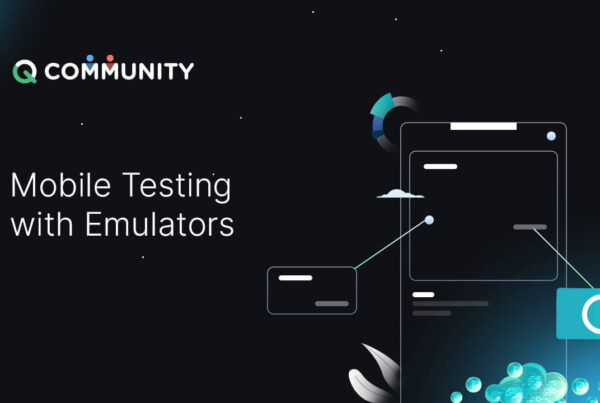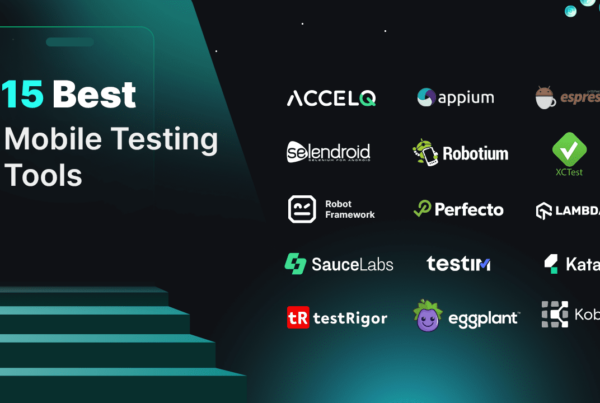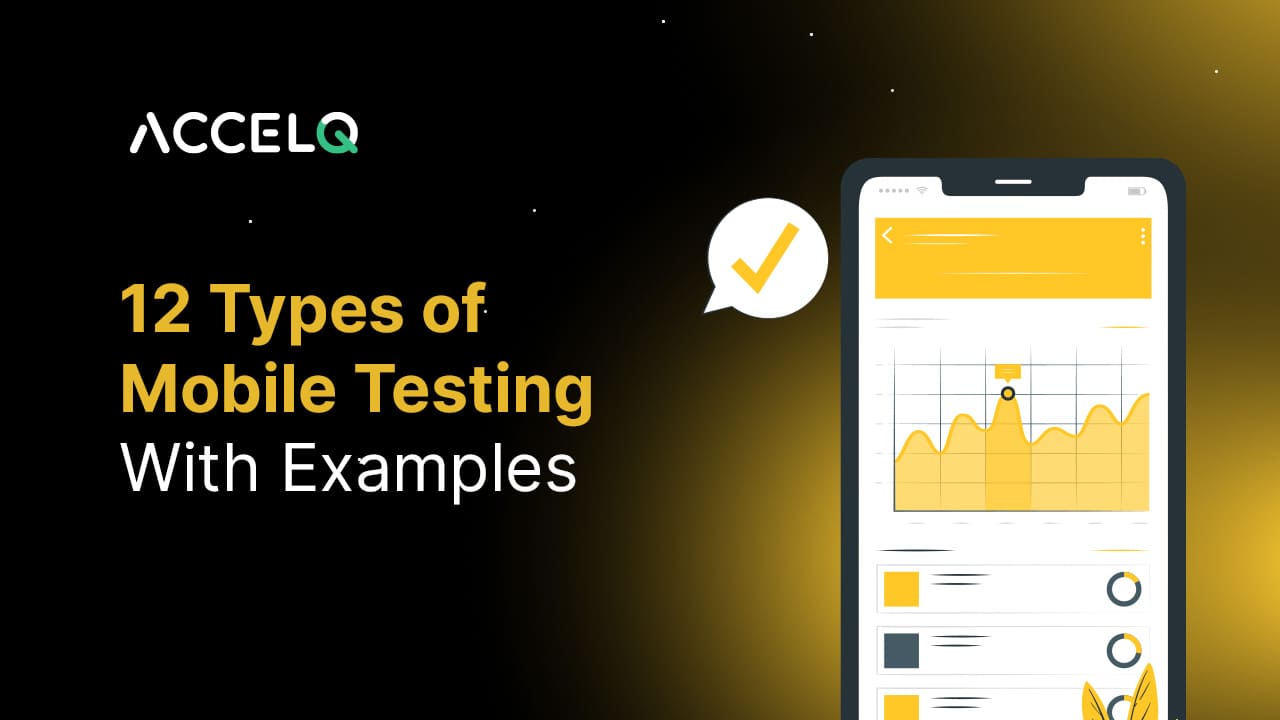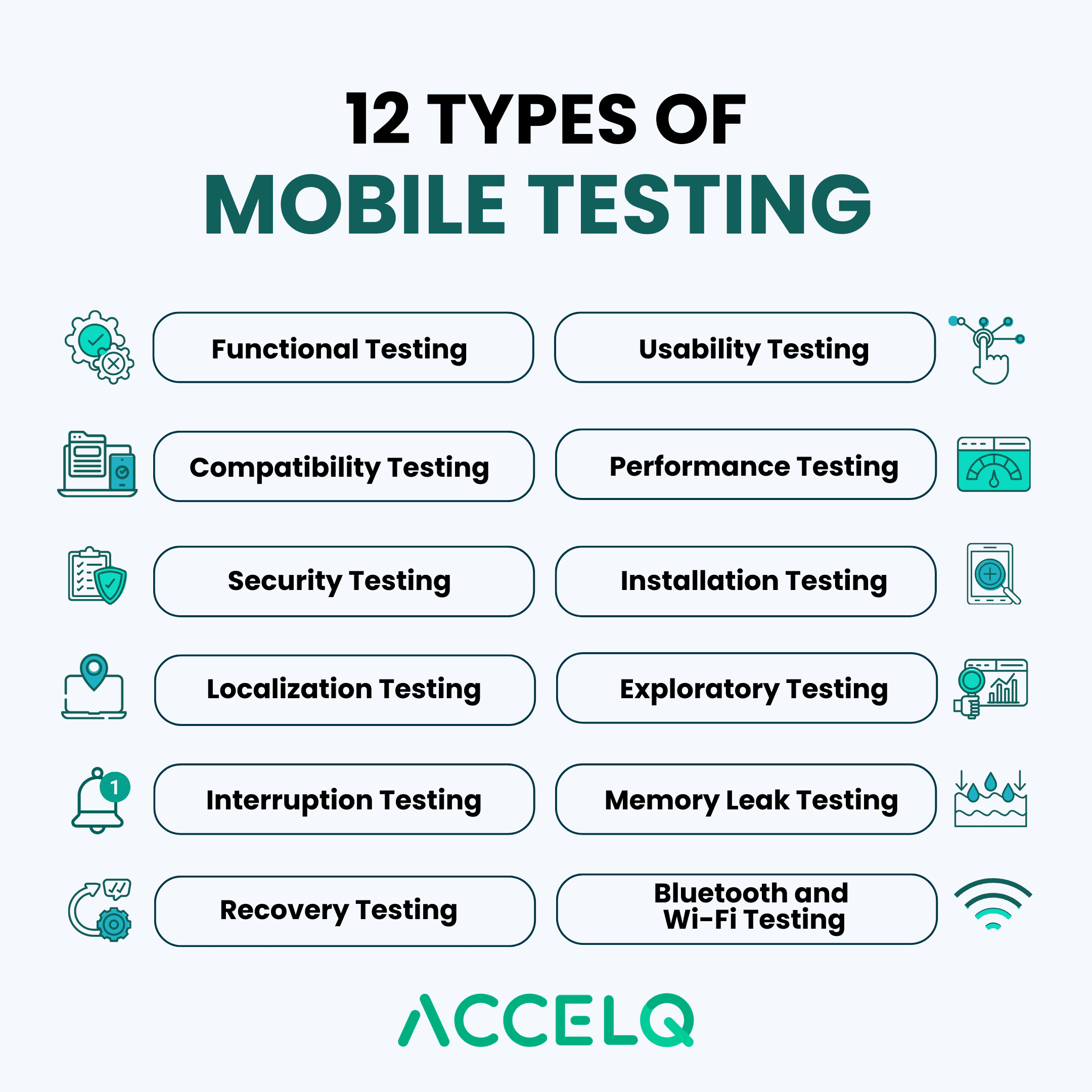Your Guide to 12 Types of Mobile Testing (With Examples)

Mobile apps have revolutionized the way businesses interact with their audiences. With over 80% of enterprises creating mobile apps, maintaining their performance and security has never been more important. And yet, when you consider the number of devices, screen sizes, operating systems, and network conditions, testing a mobile app effectively is anything but simple. That’s where various mobile app testing methods fit in — to ensure that users experience no bugs or glitches.
Why Different Types of Mobile Testing Matter?
Mobile is incredibly fragmented – from screen resolution to OS. Without proper mobile testing types and practices, apps will crash, slow down, and open doors for attacks. Therefore, a robust mobile testing approach with multistage testing is a necessity to ensure that user needs and business objectives are met.
1. Functional Testing
Functional testing ensures that every feature of the mobile app works according to its design and requirements.
Objective: Verify core functionalities like user login, payment processes, and notifications.
Process: Create detailed test cases, execute them, and validate the results.
Example: In a banking app, functional testing ensures that transferring money between accounts completes without errors.
2. Usability Testing
Usability testing concentrates on the ease with which users can use the app and perform certain tasks.
Objective: Improve user experience by making the app intuitive and simple.
Process: Observe real users navigating the app and gather feedback.
Example: Ensuring a first-time user can apply for a loan seamlessly in a mobile banking app.
3. Compatibility Testing
Different devices, operating systems, and networks require mobile applications to behave consistently.
Objective: Confirm compatibility across devices, screen sizes, OS versions, and browsers.
Process: Test the app on multiple physical devices and emulators.
Example: Making sure a banking app runs flawlessly on both Android 10 and iOS 17.
4. Performance Testing
Performance testing checks the app’s responsiveness, speed, stability, and scalability under different conditions.
Objective: Identify bottlenecks when the app is under heavy load.
Process: Simulate thousands of users accessing the app simultaneously.
Example: On payday, when millions use a banking app, performance testing ensures fast response and zero downtime.
5. Security Testing
Mobile applications that handle sensitive user data require special focus on Security testing to avoid backdoors and leaks.
Objective: Detect and fix security gaps in the app.
Process: Perform penetration testing, authentication validation, and secure data transmission checks.
Example: Verifying that a banking app encrypts user credentials and secures payment information.
6. Installation Testing
Installation testing ensures users can install, update, and uninstall the app without issues.
Objective: Confirm seamless installation across various conditions.
Process: Test app installation with interrupted networks, low storage, and update scenarios.
Example: Updating a banking app without losing transaction history or session data.
7. Localization Testing
Localization testing customizes the app for various languages, cultures, and native environments.
Objective: Validate that language, date formats, currencies, and content match the target audience.
Process: Test the app’s UI and content across different geographies.
Example: Japanese users see localized content and navigation in their native language.
8. Exploratory Testing
Exploratory testing is testing without a script, during which testers think of as many little bug hiding spots as they can.
Objective: Identify unexpected behaviors through free-form testing.
Process: Encourage testers to interact freely with the app.
Example: A tester changing transaction flows unexpectedly and uncovering workflow bugs in a banking app.
9. Interruption Testing
Mobile apps must manage interruptions like calls, SMS, notifications, or low battery alerts gracefully.
Objective: Ensure the app can resume operations after interruptions.
Process: Simulate calls, SMS, or app notifications while the app is in use.
Example: Receiving a call during an online transfer without losing transaction progress.
10. Memory Leak Testing
Memory leak testing ensures the app does not consume unnecessary memory, which can slow down or crash the device.
Objective: Detect and fix memory consumption issues.
Process: Monitor app memory usage during prolonged sessions.
Example: Ensuring a banking app runs efficiently even after hours of continuous use.
11. Recovery Testing
Recovery testing verifies the app’s ability to recover from crashes, network failures, or power loss.
Objective: Check app resilience after failures.
Process: Simulate app crashes and measure recovery time and data preservation.
Example: If the banking app crashes during a transaction, it should restore the last action without loss.
12. Bluetooth and Wi-Fi Testing
Bluetooth and Wi-Fi testing validates app performance across wireless connections.
Objective: Confirm consistent app behavior over wireless networks.
Process: Test Bluetooth-based data transfer and Wi-Fi network performance.
Example: Seamlessly syncing payment confirmations between devices via Wi-Fi.
How ACCELQ Transforms Mobile Testing?
The manual approach to testing mobile applications can be laborious and error-prone. That’s where ACCELQ changes everything with AI-driven, codeless test automation.
- Automate end-to-end mobile testing effortlessly
- Quickly adapt to new devices and OS updates
- Eliminate manual errors with intelligent test automation
- Ensure continuous quality at every release cycle
Whether it’s functional testing, performance testing, or security testing, ACCELQ enables organizations to test early and often – and to test faster. Start simplifying and accelerating your mobile testing types with ACCELQ today.
Conclusion
Getting a mobile app to work well on thousands of devices and various network conditions is very hard. From smoke testing to Bluetooth and Wi-Fi testing, each type of mobile testing is valuable for making sure apps meet performance, security, and usability from the user’s standpoint. A proactive QA mobile testing type approach will increase user satisfaction, create brand loyalty, and retain revenue.
Prashanth Punnam
Sr. Technical Content Writer
With over 8 years of experience transforming complex technical concepts into engaging and accessible content. Skilled in creating high-impact articles, user manuals, whitepapers, and case studies, he builds brand authority and captivates diverse audiences while ensuring technical accuracy and clarity.
You Might Also Like:
 Mobile Testing with Emulator
Mobile Testing with Emulator
Mobile Testing with Emulator
 How ChatGPT is Changing the Game for Mobile Testing
How ChatGPT is Changing the Game for Mobile Testing
How ChatGPT is Changing the Game for Mobile Testing
 15 Best Mobile Testing Tools
15 Best Mobile Testing Tools

































